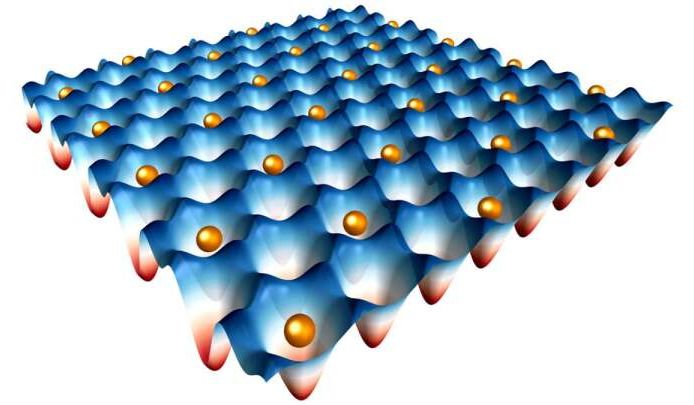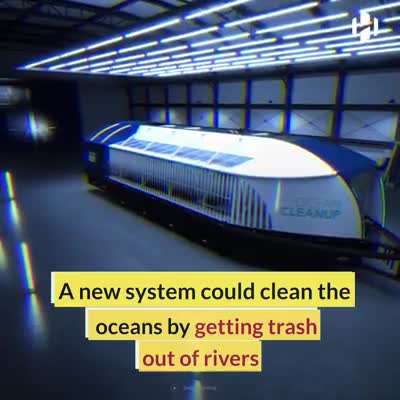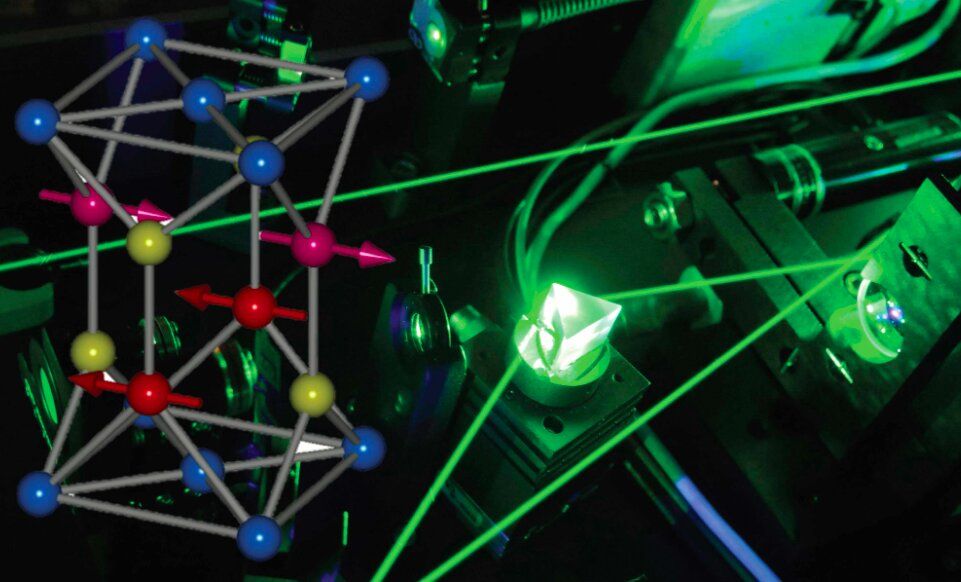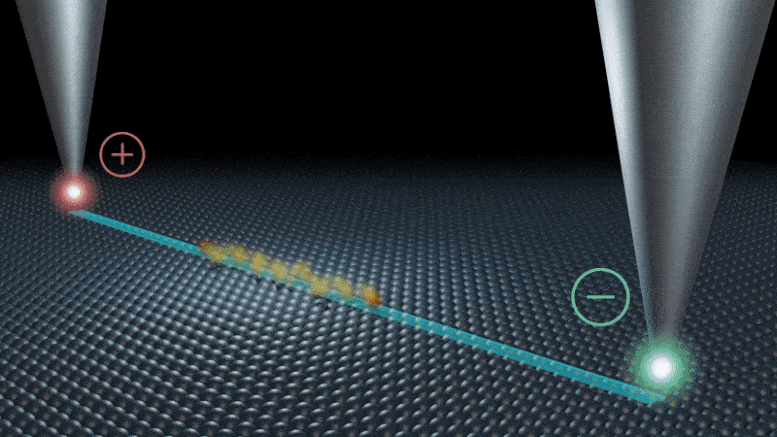New research led by researchers at the University of Toronto (U of T) and Northwestern University employs machine learning to craft the best building blocks in the assembly of framework materials for use in a targeted application.



Eighty-six years since electron crystals were first proposed, physicists have now constructed them, trapping electrons in a repeating pattern. The achievement is reported in the journal Nature.
A crystal is made of a repeating pattern of particles but electrons are difficult to keep in place. So an electron crystal is like trying to organize a large number of electrons that won’t stay still — it’s the herding cats of particle physics.
However, this team had an ingenious solution. They built a Wigner crystal using layers of semi-conductors just one atom thick. They then used two different tungsten materials and created a hexagonal pattern known as a moiré superlattice by placing one material on top of the other.

Scientists have created new kinds of ‘living materials’ by tweaking the base ingredients of kombucha – the popular tea drink fermented with a symbiotic culture of bacteria and yeast (aka SCOBY).
This kind of ‘tea fungus’ – sometimes called ‘kombucha mother’ – can do a lot more than just produce sour-tasting beverages, it seems.
By modifying the mixture of the culture, researchers were able to make engineered living materials (ELMs) that could one day have all sorts of practical applications, such as sensing light or detecting contaminants.

A new study shows that not even cosmology can verify Einstein’s assumption about the speed of light.
Special relativity is one of the most strongly validated theories humanity has ever devised. It is central to everything from space travel and GPS to our electrical power grid. Central to relativity is the fact that the speed of light in a vacuum is an absolute constant. The problem is, that fact has never been proven.
When Einstein proposed the theory of relativity, it was to explain why light always had the same speed. In the late 1800s it was thought that since light travels as a wave it must be carried by some kind of invisible material known as the luminiferous aether. The reasoning was that waves require a medium, such as sound in air or water waves in water. But if the aether exists, then the observed speed of light must change as the Earth moves through the aether. But measurements to observe aether drift came up null. The speed of light appeared to be constant.
Einstein found that the problem was in assuming that space and time were absolute and the speed of light could vary. If instead, you assumed the speed of light was absolute, space and time must be affected by relative motion. It’s a radical idea, but it’s supported by every measurement of light’s constant speed.


Antiferromagnetism is a type of magnetism in which parallel but opposing spins occur spontaneously within a material. Antiferromagnets, materials that exhibit antiferromagnetism, have advantageous characteristics that make them particularly promising for fabricating spintronic devices.
In contrast with conventional electronic devices, which use the electrical charge of electrons to encode information, spintronics process information leveraging the intrinsic angular momentum of electrons, a property known as “spin.” Due to their ultrafast nature, their insensitivity to external magnetic fields and their lack of magnetic stray fields, antiferromagnets could be particularly desirable for the development of spintronic devices.
Despite their advantages and their ability to store information, most simple antiferromagnets have weak readout magnetoresistivity signals. Moreover, so far physicists have been unable to change the magnetic order of antiferromagnets using optical techniques, which could ultimately allow device engineers to exploit these materials’ ultrafast nature.

Oak Ridge National Laboratory’s Center for Nanophase Materials Sciences, or CNMS, contributed to a groundbreaking experiment published in Science that tracks the real-time transport of individual molecules.
A team led by the University of Graz, Austria, used unique four-probe scanning tunneling microscopy, or STM, to move a single molecule between two independent probes and observe it disappear from one point and instantaneously reappear at the other.
The STM, made available via the CNMS user program, operates under an applied voltage, scanning material surfaces with a sharp probe that can move atoms and molecules by nudging them a few nanometers at a time. This instrument made it possible to send and receive dibromoterfluorene molecules 150 nanometers across a silver surface with unprecedented control.

“He uses ash from a chimney, and sifts it three or four times to remove large residues, debris, and other foreign materials. Then, he dumps the ash into a paper carton and places the tomatoes in the carton. With this technique, Mr. Nduwimana manages to safely store his tomatoes for many months. He explains: “I keep my tomatoes in the ash for a period of five to six months, so I can sell them in December, January, or February when the price has risen—since tomatoes are rare and become expensive during this period.””
Vital Nduwimana hated how many tomatoes he lost every season. For years, his tomatoes started rotting just three or four days after harvest. He felt frustrated.
Mr. Nduwimana explains: “I was not able to sell all my tomatoes; I lost almost half of my production. Worse still, I would sell at a low price in the market. So in 2015, I thought that maybe I should find a tomato conservation technique.”
Mr. Nduwimana grows tomatoes in eastern Burundi, on Kabuyenge hill, five kilometres from the Tanzanian border.

From the outside, VertiVegies looked like a handful of grubby shipping containers put side by side and drilled together. A couple of meters in height, they were propped up on a patch of concrete in one of Singapore’s nondescript suburbs. But once he was inside, Ankesh Shahra saw potential. Huge potential.
Shahra, who wears his dark hair floppy and his expensive-looking shirts with their top button casually undone, had a lot of experience in the food industry. His grandfather had founded the Ruchi Group, a corporate powerhouse in India with offshoots in steel, real estate, and agriculture; his father had started Ruchi Soya, a $3 billion oilseed processor that had been Shahra’s training ground.

Researchers from Yokohama National University in Japan have developed a prototype microprocessor using superconductor devices that are about 80 times more energy efficient than the state-of-the-art semiconductor devices found in the microprocessors of today’s high-performance computing systems.
As today’s technologies become more and more integrated in our daily lives, the need for more computational power is ever increasing. Because of this increase, the energy use of that increasing computational power is growing immensely. For example, so much energy is used by modern day data centers that some are built near rivers so that the flowing water can be used to cool the machinery.
“The digital communications infrastructure that supports the Information Age that we live in today currently uses approximately 10% of the global electricity. Studies suggest that in the worst case scenario, if there is no fundamental change in the underlying technology of our communications infrastructure such as the computing hardware in large data centers or the electronics that drive the communication networks, we may see its electricity usage rise to over 50% of the global electricity by 2030,” says Christopher Ayala, an associate professor at Yokohama National University, and lead author of the study.